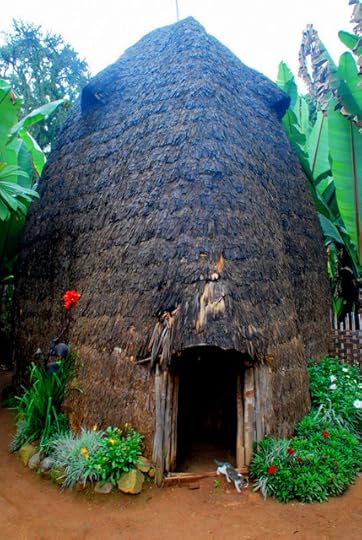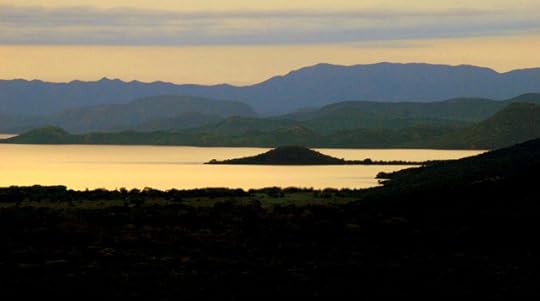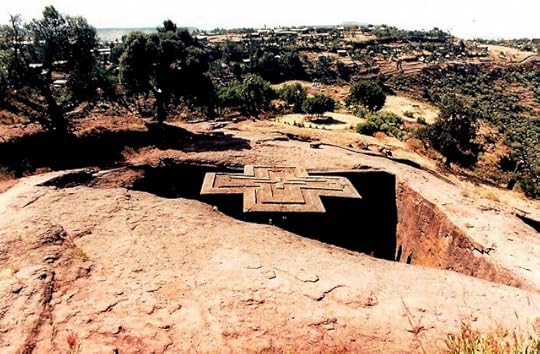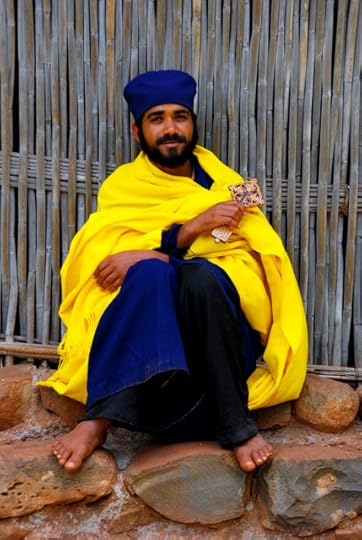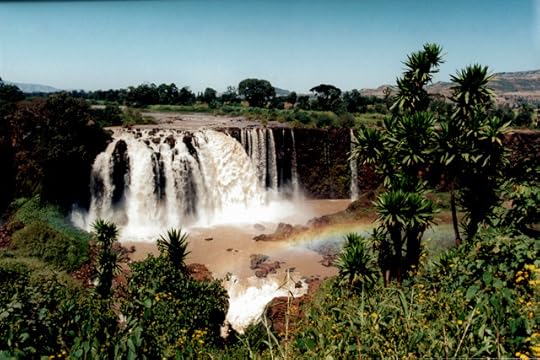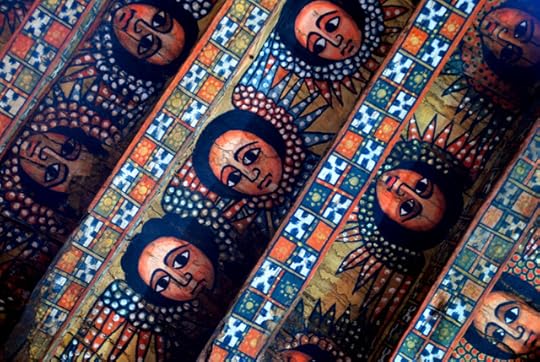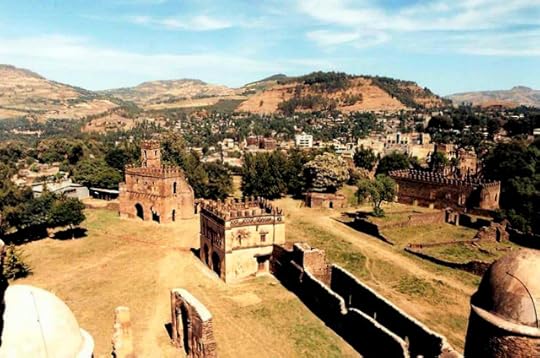Roderick Phillips's Blog, page 5
June 6, 2014
Mursi tribe, Omo valley, Day 312
I suppose the accompanying image renders any attempt at a suspenseful blog moot. So instead I’ll shout it loud and clear from the roof tops that Christi and I (with a little help from our marvellous driver-guide Fekade) made it one of the Mursi villages in the Omo river valley. And I was able to photograph to my heart’s content. I’m guessing these Mursi people have been photographed before because as soon as they see us approach they disappear briefly and reappear wearing all manner bangles, baubles, and headdresses to make themselves appear more photogenic (which works!). And it’s not that they are excited to be photographed (at least by me), but because they expect to be paid per photo. And these guys are not stupid either. They count each time the camera clicks so they know how many photos you have taken. And they expect to be paid for each photo even if it is out of focus or their eyes are closed etc. This is a little frustrating because these men and women are quite animated until the camera is pointed at them and then they turn very serious and stare at the camera (no doubt calculating how much money they are making). In that sense, the Mursi utilize their uniqueness for commercial gain and I have no problem with that. If this money helps their culture to survive then it is a win-win situation as far as I am concerned.
Some less than charitable reports (including in such enlightened publications as the Lonely Planet) have portrayed the Mursi as aggressive and light-fingered which is grossly unfair. My only issue is that everyone wants to be photographed and I’m running out of money. Christi pays 2 Birr (about 15 cents) per photo so we need a lot of 1 Birr notes. And new ones to boot. The Mursi refuse to accept dirty or torn notes because shopkeepers will not accept them. As I photograph each person, I call out to Christi how many photos I’ve taken. Normally full length, half shot, shoulders, and portrait so each person gets 8 Birr. Eventually I take 5 shots so that we can give a 10 Birr note instead. There are also warriors, some of whom look real mean, so I photograph to avoid any trouble. Then there are the old women, and girls with extensive body scarring. The fact that these girls have to be topless to see the extent of the scarring is an added bonus!
The experience is undeniably intense and so focused am I on the photography that Christi and I learn little about the culture of the Mursi. We are standing in the middle of their village and the surrounding huts are the smallest I’ve seen so far, so maybe they spend little time inside them. The Mursi are traditionally pastoralists (herding cattle, but also cultivating crops) and animists (a belief that all plants, animals, and inanimate objects have a spiritual essence). Of course the burning question is why do the women wear the lip discs. There appears to be no definitive answer. Beauty may be one aspect, but it appears to be more of an overall sense of worthiness within their culture. The bigger the disc, the more worthy the woman particularly in her connection to the Mursi culture. It appears that fewer girls are choosing to have lip discs these days, but in those that do the lower lip is normally split at age 15 or 16 and a wooden plug inserted until the lip heals. Over the ensuing months progressively larger clay discs are inserted stretching out the lip. The circumference of the disc can be as much as 6 inches. One question that I dared not ask is how this affects eating and kissing. Even if kissing is not important part of the culture is it easy to eat with a flabby lower lip. And what about drooling? As impressed as I am with the Mursi, I don’t think the lip disc will catch on in the West. I mean how would I kiss Christi if she was wearing a lip disc? And if she took it out I feel I’d be chasing her lower lip all over her face or could you imagine having someone’s lower lip actually wriggling around inside your mouth. So gross. That disturbing image aside what a spectacular day.
On that note we leave the Mursi to count their Birr and return to Jinka. The dry weather made our journey on the gravel road through the Omo valley and Mago National Park so much easier than the bog we had to negotiate on our previous (and unsuccessful) attempt to reach the Mursi. And I must just mention in case the photos don’t really do the Omo valley justice, but the grasslands in this area are the lushest and greenest I have ever seen. Ethiopia continues to surprise and amaze me. I hope you feel the same way.

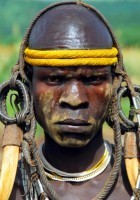


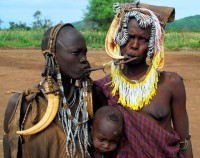

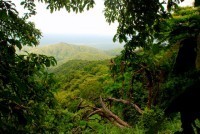
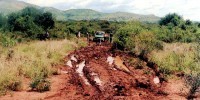
Blog post by Roderick Phillips, author of Weary Heart – a gut-wrenching tale of love and test tubes.
The post Mursi tribe, Omo valley, Day 312 appeared first on Roderick Phillips.
June 5, 2014
Dorze tribe, southwest Ethiopia, Day 311
Today Christi and I will start visiting some of the incredibly diverse ethnic groupings that call southwest Ethiopia home. In fact, it is only within the last few decades that some of these tribes realized they lived in a country called Ethiopia. For most of their history, these tribes have been oblivious to geopolitical events unfolding around them. Their main concern was inter-tribal warfare where raiding parties carried off domestic animals and women. Of course even in this remote part of Ethiopia the accoutrements of modern living are gradually infiltrating the traditional way of life, none more so than automatic weapons. Many of these ethnic groupings are small in number and in the era of bows and arrows and spears loss of life was modest. In the era of the Kalashnikov, however, rapacious loss of life could see the end of one or more of these indigenous peoples. Another reason to visit now before their lifestyle changes beyond all recognition. Fekade begins our cultural safari with the Dorze people who live in the Chencha mountains above Lake Chamo and Lake Abaya. And the Chencha mountains are lush with vegetation, which require significant annual rainfall and boy is it precipitating today.
Perhaps the most iconic feature of the Dorze tribe are their elaborate beehive huts, which can reach heights of 12 m (36 feet). Our guide, a rastafarian-looking chap by the name of Macoonan and nephew of the village chief, says the huts resemble the head of an elephant. And much like the longevity of elephants, these huts were built to last (up to 70 years). The huts are built of bamboo and thatched with false banana leaves. And here’s an amusing point that may resonate with some of you, these huts suffer from termite damage. Unlike the West however where you call up the termite exterminator to rid your property of the pest, the Dorze take matters into their own hands. Apparently the toothy termites start nibbling away at the base of the hut so the Dorze solution is to hack away the diseased wood, in effect turning a two-story hut into a bungalow!
The interior of the hut is dark and smoky and it takes some time for our eyes to adjust to the murky light. When they do we realize we are not alone. There are several cows in one part of the hut happily munching on some leaves. The animals are kept inside for two reasons. First, as a security measure to prevent pesky cattle rustlers from stealing them and second to keep the hut warm (it’s not exactly practical to have a roaring fire in a house made of bamboo, although a modest one is burning away quite gently). Did I mention that it is freezing up here in the Chencha mountains. Outside we get see some of the locals going about their daily work, utilizing naturally growing materials. Cotton is used for weaving, while the false banana plant is used for many purposes: the trunk and roots are used to make bread and porridge; the leaves are used for thatching huts; and fibers from the trunk are used to make rope.
We cannot dillydally all the day in the mountains, though, as we have another long bumpy ride to the last town of any size in southwest Ethiopia, Jinka. The further we go, we begin to encounter an increasing diversity of ethnic groupings based on different clothing, body decoration, and hairstyles. I’m desperate to photograph every face I see, but we will never reach Jinka if I do. And if we don’t make it to Jinka, we will not have a launch pad for our foray into the remotest corners of the Omo valley to finally meet the Mursi. One way or another tomorrow will be an exciting day…
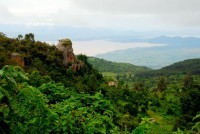
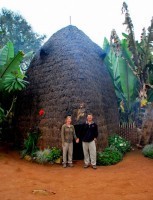
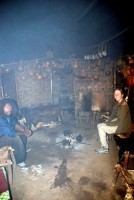
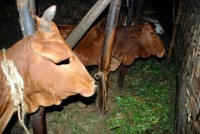

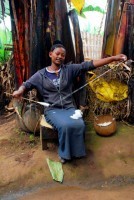
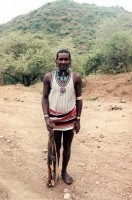
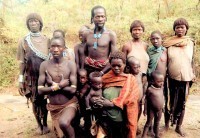
Blog post by Roderick Phillips, author of Weary Heart – a gut-wrenching tale of love and test tubes.
The post Dorze tribe, southwest Ethiopia, Day 311 appeared first on Roderick Phillips.
June 4, 2014
Addis Ababa to Arba Minch, Day 310
I think a little context is in order to explain why Christi and I are so excited by the prospect of exploring the remote south-west of Ethiopia beyond Arba Minch and down to the Omo valley. First and foremost the reason we are going is because we tried and failed in the past to find one of the most iconic tribes in Ethiopia if not Africa generally, the Mursi, who inhabit the Omo valley area. (And I hate failure). The ironic thing is that we were part of a Dragoman overlanding trip at the time and a visit to the Omo valley was not even part of the itinerary. The tour leader, a dominating blonde woman of quite voluptuous proportions (as exotic to the indigenous inhabitants of the Omo valley as they were to us) persuaded the group to go along with her crazy scheme. To be honest Christi and I were not familiar with the Omo valley and its inhabitants and we were happy to simply see as much of Ethiopia as possible. There are numerous ethnic groupings in the southwest of the country and they don’t all get along (it’s a bit like the US Congress), but perhaps the most impressive are the Mursi. We had hoped to see them in the small market town of Jinka, but none were there when the Dragoman truck staggered into town. We were determined to keep going and so the decision was taken to drive out to their remote villages, some 50 miles away. This was going to be a challenging trip because the roads were deplorable (this being the wet season). Our tour leader baulked at taking the truck any further and so we rented two 4WD vehicles. The vehicles were not in good condition and the road was basically a bog. It took us 7 hours to go 35 miles and we still had 15 miles to go when a vote was called whether to continue. The concern was having to sleep outside at the Mursi village (we hadn’t brought tents with us) and the risk of tsetse fly bites (which can be fatal) and light-fingered locals. After getting so close the group decided to give up (Christi and I, the tour leader, and one other passenger voted to continue) the rest clamoured for a hot bath and a beer back in Jinka after congratulating themselves on ‘a good effort’. It’s been a while, but we’re back (well we are on our way) and this time failure is not an option. Christi has vowed to giver her life (now that’s what I call dedication) to ensure I finally get to meet the Mursi.
Back to the present…we leave the luxury of the Hilton hotel at 7 am for the 500 km drive to the Paradise Lodge at Arba Minch overlooking Lake Chamo and Lake Abaya. The name of our hotel and its location sound fancy, but the southwest of Ethiopia is not renowned for high quality accommodation so time will tell. Our driver-guide incidentally is the amazing Fekadeselassie Yosef. If you are planning a trip to anywhere in Ethiopia then this guy should be your number one choice (write to me for his contact details). And if you contact him directly then you can avoid the additional fee that Explore Abyssinia Travel charged us for organizing this trip. As with any big city, actually getting out of the place is a challenge, but very soon after that we are driving through quite beautiful pastoral scenery. Our first stop is at Lake Ziway for a spot of bird-watching. Apparently both Fekade (as he is known) and Christi are amateur twitchers. The lake is home to amongst others one of the largest and ugliest birds in the world, the Marabou stork and the sacred ibis.
A lunch stop at Shashamane, which is right up there with Ouarzazate in Morocco for sheer lyrical pleasure. South of Shashamane rural life really kicks in. The roads are used by everyone for every conceivable purpose and everyone believes they have the right of way. We see endless herds of goats, cattle, and sheep; donkeys and carts; men on horseback; women struggling along with 5-gallon Jerry cans of water or weighed down with firewood; not to mention a million school kids. Much of the area is under cultivation with sorghum and wheat being the major crops.
At one point (ironically on one of the better sections of road we get our first flat tire). Fekade fixes it with ease, but he does attract a crowd of people willing to offer him help and advice, which is more than Christi and I are capable of doing. Instead I photograph the locals and their classic round thatch huts, which really does remind one of the classic Hollywood-inspired imagery of Africa. And for the most part Africa is not like that, which makes southwest Ethiopia all the more appealing. Eleven hours after leaving Addis Ababa we arrive at the Paradise Lodge overlooking Lake Abaya and Lake Chamo in Arba Minch. And it really does live up to its billing, especially with the comfortable beds, mosquito nets, and luxury of luxuries a western-style sit-down toilet (thank you). There are an abundance of amenities including internet access, spa, massage, and sauna facilities, and lake cruises (for crocodile watching among other things). It would be nice to stay awhile, but we don’t have time or the money to indulge in this little slice of heaven. The good news is that Christi has not had to risk her life to ensure this trip is a success – well, not yet, anyway.
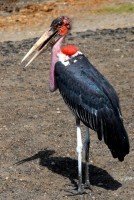

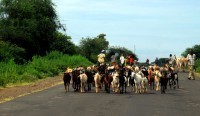
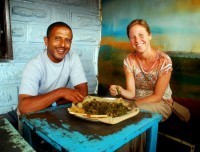
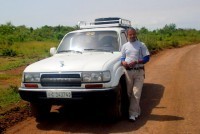
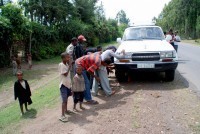
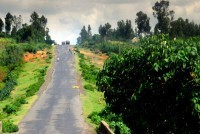
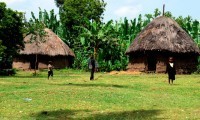
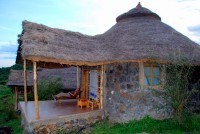
Blog post by Roderick Phillips, author of Weary Heart – a gut-wrenching tale of love and test tubes.
The post Addis Ababa to Arba Minch, Day 310 appeared first on Roderick Phillips.
June 3, 2014
Aksum, Ethiopia, Day 309
Life in the Hilton hotel in Addis Ababa is just swell. Christi and I continue to kick back and live like royalty. Perhaps in our entire Year of Wonder we have never had two days off in a row (from sightseeing, traveling, planning, and doing chores). In some ways it is addictive. Our bodies have been running on adrenaline for months and now that we’ve stopped, albeit briefly, the adrenaline levels are falling and Christi and I are in danger of collapsing from sheer fatigue. Fortunately we move on again tomorrow, assuming we can drag our tired bodies out of bed. But rather than dwell on the massage that Christi has scheduled or my sunbathing by the pool with a cold soda in my hand, let’s continue our reveries. The third of the major Christian towns in northern Ethiopia after Gonder and Lalibela is Aksum.
Aksum is considered to be the holiest city in Ethiopia and is an important destination of pilgrimages. The reason being The Ethiopian Orthodox Church claims (but will not agree to external verification) that the Church of Our Lady Mary of Zion (the most important church in the country) is the final resting place of the Ark of the Covenant (which means that the one uncovered by Indian Jones in Raiders of the Lost Ark is a fake!). For those of us whose biblical knowledge is a bit sketchy, the Ark of the Covenant supposedly contains the stone tablets on which God wrote the 10 Commandments and then gave them to Moses on Mt. Sinai. There is some evidence to support the claim that the Ark may have traveled to Ethiopia, perhaps even to Aksum. Local history suggests that the Queen of Sheba came from modern-day Ethiopia and journeyed to Jerusalem to meet King Solomon. One thing led to another and 9 months later out popped Menelik I (who became the first Solomonic King of Ethiopia around 950 BC). Menelik grew up in Ethiopia but traveled to Jerusalem as a young man to visit his father’s homeland. He lived for several years in Jerusalem before returning to Aksum with the Ark of the Covenant. Furthermore, the (unimpressive) ruins of what are believed to be the palace of the Queen of Sheba have been excavated around Aksum.
Christianity was certainly not the only game in town, however. Between the 2nd century AD and the 10th century AD the Kingdom of Aksum flourished at the same time the Kingdom of Kush went into decline. And rather than use pyramids for their tombs as they did in Sudan and Egypt, the Aksumite kings built stelae (or obelisks) to mark their underground burial chambers. The largest of the grave markers were for royal burial chambers and were decorated with multi-story false windows and false doors, while nobility would have smaller, less decorated ones. King Ezana’s Stela is 70 feet (21 m) tall and weighs 160 tons. It is the second largest still standing now that the Italians repatriated the Obelisk of Aksum (24 m tall) a few years ago. The largest of all the stelae, the 33-m tall Great Stele, is believed to have never stood, but instead toppled over as it was being erected. It weighed in excess of 500 tons and once again boggles the mind as to how this single piece of granite could be excavated, transported from a quarry 4 km away, and erected with only the odd donkey to aid man’s ingenuity. Some say the ancient Aksumite Kings harnessed the celestial power of the Ark of the Covenant to erect these massive stone obelisks. I say it’s too hot to worry about such things and waiter, can I have another cold soda please. Just bill it to the room, there’s a good chap.
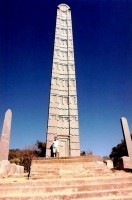
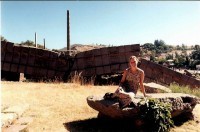
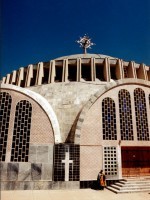
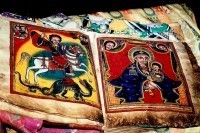
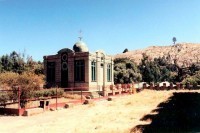

Blog post by Roderick Phillips, author of Weary Heart – a gut-wrenching tale of love and test tubes.
The post Aksum, Ethiopia, Day 309 appeared first on Roderick Phillips.
June 2, 2014
Lalibela, Ethiopia, Day 308
It’s been a long time since Christi and I have stayed in a hotel as luxurious as the Hilton in Addis Ababa and for the next couple of days we intend to eat, sleep in a deliciously comfortable king-size bed, soak in the bath, swim in the hotel pool, sweat in the hotel sauna, order room service (just because we can) and generally relax ahead of our long trip south into the Omo valley. Unfortunately, that will not make for interesting blog posts and I do aspire to interest and excite you all with tall tales and adventures from the road, so I thought it might be fun to revisit our previous trips to Lalibela (Africa’s Petra [in Jordan]) and Aksum.
Lalibela, Aksum, and Gonder represent the Christian religious north of Ethiopia (about 60% of the country practices Christianity, 33% Islam, and the remainder are animists). In our previous trip, Christi and I completed the Northern Circuit aboard a Dragoman truck. It was one hot and very long and bumpy ride to this isolated community, but cheaper than flying (which is what sane tourists do). The town of Lalibela does not immediately inspire awe, other than for its elevation (over 8,000 feet) and steep roads – a combination which really does your breath away. Dating to the 12th century, the town is rather small with a population of about 15,000 people (most of whom appear to be involved in either the business of religion or tourism, although the lines are a little blurred). What is not in dispute are the magnificent rock-hewn churches of Lalibela (also dating to the 12th century) which now enjoy UNESCO World Heritage status.
Eleven churches have received UNESCO protection, including Biete Medhane Alem (regarded as the largest rock-hewn church in the world and at the time of our visit covered in scaffolding), St. Gabriel’s Church (perhaps the most atmospheric. A tunnel connects the church to a holy bakery), and St. George’s Church (the most visually stunning of all the rock-hewn churches. It is dedicated to St. George, who, in addition to being the patron saint of Ethiopia, is also the patron saint of England). It feels as if we are attempting an assault course as we clamber up and down steep steps and ladders, scramble through darkened tunnels, and dodge animals, tourists, and purveyors of tourist ephemera. It is remarkable how many unique antique crosses are for sale in Lalibela. Either Ethiopia is selling its cultural soul or there are some enterprising silversmiths in town. One cross whose identity is not in question is the 7 kg gold Lalibela Cross found in Biete Medhane Alem. Lost between 1997 and 2001, it eventually turned up in Belgium and was returned ‘no questions asked’. It is believed that this cross actually belonged to King Lalibela who was responsible for the construction of the rock-hewn churches in the 12th century. The Lalibela Cross is one of the country’s most revered national treasures and, better late than never, armed guards are now in attendance when the cross is displayed to the public.
The most astonishing thing about Lalibela is how undeveloped this small isolated town is and how much the churches are just part of the lives of the locals. Indeed, as we exit one group of churches we are literally walking through someone’s backyard. Children are playing, oblivious to the camera-toting tourists in their midst, while sheep and goats graze contentedly and surrounding it all are piles of rubbish and feces. This is authentic, organic tourism before it becomes an industry and I love it – well, except for the pongy poo.
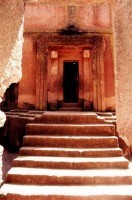
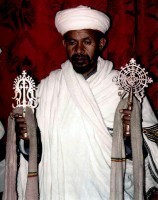
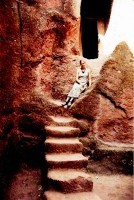
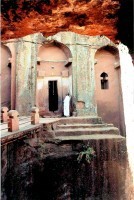
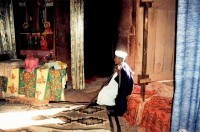
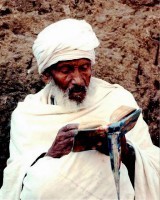


Blog post by Roderick Phillips, author of Weary Heart – a gut-wrenching tale of love and test tubes.
The post Lalibela, Ethiopia, Day 308 appeared first on Roderick Phillips.
June 1, 2014
Rural Ethiopia, Day 307
Christi and I have a disgustingly early start for our all-day drive south through rural Ethiopia to the capital of Ethiopia, Addis Ababa. We’re up at 4 am and outside the (locked) bus station in the dark by 4:40am. It’s a little uncomfortable mingling with the locals in the dark and we are relieved when the gates open and everyone rushes in. We find our way to the Selam bus where our bags are swiftly deposited on the roof under a tarp and we take our assigned seats (7 and 8). So far so good, but public transport in Ethiopia can be challenging. For a start, the date on the ticket is 8 years earlier than the actual current date used by the rest of the world (because Ethiopia follows the Julian calendar while the rest of the world follows the Gregorian calendar). In addition, the time of departure on our tickets is 11 pm the night before. The explanation for this complicated system is that in Ethiopia the day begins at dawn, roughly 6 am, and not at midnight so a 5 am departure is the last hour of the previous day i.e. 11 pm. It is important to know when traveling by public transport whether the departure time is farangi (foreigner) time or local time. Just another reason to love Ethiopia. In the event we leave at neither 5 am nor 11 pm, but 6 am FT (farangi time).
It is an absolutely wonderful ride through rural Ethiopia: the whole country seems in the midst of a farming frenzy. The people in Ethiopia are super friendly and curious about farangis because the locals see so few tourists. And because the bus does not have a toilet on board (no public bus in Africa has had a toilet on board so far, unlike South America where all the buses had toilets – some even had beds [I do miss that]), we stop frequently and I use every moment to photograph life in rural Ethiopia (markets, religious ceremonies, In addition the frequent toilet stops our other main impediment to swifter progress is the number of animals sauntering across and along the roads. Lunch is at Debre Markos around 10:30 am. Christi and I enjoy the local delicacy injera with wat (meat and vegetable sauces) and then explore the local market for a few minutes before we are called back to the bus by an insistent driver.
The most stunning part of the whole drive comes as we enter the Blue Nile Gorge. It takes more than an hour to drive to the bottom of the gorge, cross the new bridge and climb up the other side. It is a steep, winding, and absolutely spectacular route. After this I just want the journey to be over. But the closer we get to Addis Ababa, the worse the traffic becomes, until we’re eventually crawling along past rain-soaked, gray buildings. We reach the Selam bus station at 4 pm, where we have to haggle hard for a decent taxi fare to the Hilton hotel. I’m sure if we were staying in some backpacker hovel, the price would have been less.
Of course the Hilton hotel would not normally be in our budget, but I had accumulated a lot of air miles from a lot of business flights and I’m now cashing those in for a few nights of luxury in the Hilton Addis. Christi and I can’t wait. By 5pm we are gorging ourselves on sumptuous Hilton luxury. It almost brings a tear to my eye to see a king-sized bed, soft sheets, pillows, and blankets, an immaculate bathroom with soap, shampoo, and body wash not to mention a TV and phone. There is also complimentary water and fruit, and wi-fi and a mini-bar. Sheer heaven. Eat Asian food in the Hilton restaurant for dinner and collapse most contentedly into bed. I may never leave this place.


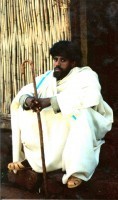



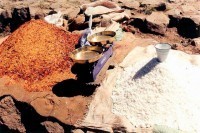
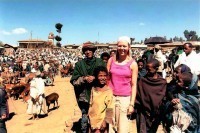

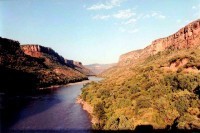
Blog Post by Roderick Phillips, author of Weary Heart – a gut-wrenching tale of love and test tubes.
The post Rural Ethiopia, Day 307 appeared first on Roderick Phillips.
May 31, 2014
Lake Tana, Ethiopia, Day 306
Our hotel, the Ghion, is situated on the banks of Lake Tana and Christi and I enjoy a relaxed breakfast overlooking the lake before taking a tour to just a few of the dozens of monasteries dotted around the lake. Lake Tana itself is about 84 km long and 66 km wide, with a maximum depth of 15 meters. It is the largest lake in Ethiopia and as I have mentioned before the source of the Blue Nile. As an added bonus all boat trips around Lake Tana include a stop to see where the water exits the lake and begins its 900-mile journey through Sudan and Egypt to the Mediterranean Sea.
Supposedly, the remains of ancient Ethiopian emperors and treasures of the Ethiopian Church are kept in the isolated island monasteries, some of which date as far back as the 14th century. For today, Christi and I decide to join a small tour. They are the usual backpackers, but also an American gynecologist on a busman’s holiday to Bahir Dar (she lives in Florida). She tells us that female circumcision of which Ethiopia is a proponent can go horribly wrong, leading to the formation of internal fistulas (holes) that require delicate and sophisticated surgery to correct serious genitourinary issues. Not surprisingly there are few if any surgeons in Ethiopia with this expertise, which is why she is here. Oh the conversations one can have while traveling.
We zoom across the lake for 40 minutes in a small motor boat, the wind blowing in our faces, to reach our first monastery, Entos Eyesu. We disembark onto a lava breakwall and follow a pleasant trail through lush tropical vegetation (the shade brings welcome relief from the heat of the day) to the monastery, which is a simple round structure. One thing theses monasteries are good at is making money and some of it appears to go on restoring (or replacing) the murals, which look as if they may have been painted yesterday. The murals depict various scenes, but I like the fighting angels best. They may have wings, but they look tough. There are also monks wandering around who are only too willing to show off religious artefacts and allow you to photograph them.
The second monastery we visit is Ura Kidane Mehret, which is actually located on the Zege peninsula of Lake Tana, rather than an actual island. Ura Kidane Mehret monastery is an Ethiopian Orthodox Church and part of the larger Convent of Mercy complex. The monastery dates to the 14th century, although the present circular church was constructed in the 16th century. Once again there are many beautiful murals, looking rather more jaded than those at Entos Eyesu, together with some prayer drums. The church also has a separate treasury where the most important artefacts are housed, including the crowns of former emperors.
Fortunately the monks don’t force the religion down our throats, are happy to pose for photos, and generally make our visit a pleasant experience. Ethiopia is just such a beautiful and laid back country to explore.
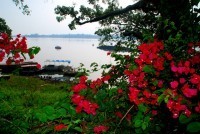
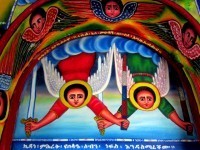

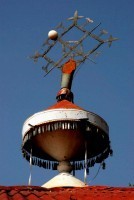


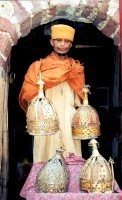

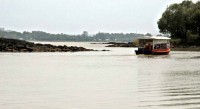
Blog post by Roderick Phillips, author of Weary Heart – a gut-wrenching tale of love and test tubes.
The post Lake Tana, Ethiopia, Day 306 appeared first on Roderick Phillips.
May 30, 2014
Blue Nile Falls, Day 305
Seyoum, the owner of Explore Abyssinia Travel and Lodge du Chateau is a resourceful chap and has no end of ideas for separating Christi and I from our money. In addition to our lodging (400 Birr[US$30] for 2 nights), laundry (135 Birr – returned wet note!) and breakfast (70 Birr), he also has a mini bus that just happens to be going to Bahir Dar today. And Bahir Dar is our next destination. We are slowly making our way down to Addis Ababa (the capital of Ethiopia) to meet with our tour guide for the trip to the Omo Valley (and that trip was a whopping 32,000 Birr organized through Explore Abyssinia Travel). Seyoum says this trip will depart Addis for the deep south in 5 days. Seyoum is also happy to give us a ride to Bahir Dar – as long as we pay him (50 Birr each). What did Seyoum do for money before Christi and I came along, I wonder to myself as I hand over yet more cash.
Having said that, it is a great ride – undoubtedly better than the horrid, if speedy (and dangerous) minibuses. Today appears to be market day all over this part of Northern Ethiopia and we see endless villagers taking their wares and livestock to local markets. It’s undoubtedly a hard life they lead, but the Ethiopians we see all look happy and healthy. The land through which we drive is heavily cultivated and cattle-drawn simple plows are everywhere. That land not under cultivation is covered in dazzling luminescent green grass – a color that is further enhanced by the rufous-red soil. The 3-hour drive to Bahir Dar is simply wonderful and dispels any lingering myths about the arid, starving country that made the news 30 years ago.
Seyoum even drops us at our new hotel, the Ghion, on the shores of Lake Tana, which has the distinction of being the source of the Blue Nile. Christi, in ebullient mood, even negotiates our room rate down to 250 Birr (US$18.50) per night from 300 Birr. Our room is fairly basic and visually the bathroom is a little grim, but there is a mosquito net. Malevolent mosquitoes and other ferocious biting bugs will plague us from now until the end of our Year of Wonder.
There are two main activities in Bahir Dar. The first is visiting some of the many monasteries that dot the lake and the second is to visit the Blue Nile Falls, known locally as Tissisat (Smoking Fire). Or at least there were two spectacles to enjoy. A few years ago a hydroelectric power project was constructed upstream of the falls that diverted water away from Tissisat, leaving behind a thin ribbon of water – a tear if you will lamenting the end of one of the world’s great natural water features. Where once a mighty crown of water roared over the cliff, showering visitors with spray and pounding ear drums with its thunderous rage, now an inconsequential dribble leaks over the black basalt rock like a man with prostate problems.
But let’s not dwell on such negative thoughts and return to a time when the Blue Nile Falls were at their magnificent best. When their power and majesty were seen for miles around and the falls truly were an iconic emblem of Ethiopia. The locals flock to greet us as we leave the village of Tissisat and cross the 17th century Portuguese bridge over the Blue Nile some distance downstream of the falls. The locals are eager to sell us drinks and souvenirs and guide us to scenic vista. There’s a frisson of excitement in the air as we follow a narrow, winding trail up to the viewpoint. There are no platforms or barriers; nothing to separate you slipping into the Blue Nile, and I appreciate this unspoilt approach to such a major attraction. ‘You like?’ my 10-year-old guide asks. ‘Magnificent,’ I reply as my camera comes up to my eye and I snap away with unabashed enthusiasm. Up to 45 meters high and 400 meters wide in full flow, Tissisat is the most impressive cataract on the entire length of the Nile River. We continue downhill along a beautiful trail to a stream, which is more treacherous than it looks. My 10-year-old helper insists on carrying my hiking boots and camera across first and then comes back to hold my hand and guide me. A little further along we reach the base of the falls and the noise is deafening and the spray lands on my face (and camera) in big, thick drops. It is very refreshing in an otherwise hot day. Another pleasant amble over rolling hills and beside some cultivated fields brings Christi and I to a dock upstream of the falls. Industrious fishermen use their small boats to ferry Christi and I across the Blue Nile to the right side of the river. A short walk brings us back into the village of Tissisat where we enjoy a cool drink and a snack before returning to Bahir Dar.
That is my memory of the Blue Nile Falls. Which only goes to show that the world is changing very fast so get out there and start exploring now, before it’s too late.
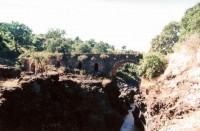


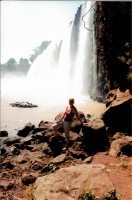
Blog post by Roderick Phillips, author of Weary Heart – a gut-wrenching tale of love and test tubes.
The post Blue Nile Falls, Day 305 appeared first on Roderick Phillips.
May 29, 2014
Debre Birhan Selassie Church, Day 304
This is our last day in Gondar and Christi and I had planned to visit the nearby Debre Birhan Selassie Church. However, Sayoum knows we want to visit the Omo Valley and he keeps talking about various options and showing us pictures. Sayoum is a rather good salesman and we are soon in deep negotiations. These are not short trips and neither are they cheap. The Omo Valley is a long way from nowhere. Travel is hard and a 4WD vehicle is de rigeur. If something goes wrong here then we will be in serious trouble. We need a reliable guide who speaks good English and who has a reliable vehicle. Neither of these things come cheap. Sayoum thinks we should do 14 days, we offer 8 and eventually compromise on 10. He shakes his complaining that we are missing out on so much and that there will be some unavoidably long travel days. He clearly thinks that he can squeeze a little more money out of Christi and I, but I’m already concerned by the existing price we have been quoted: 32,000 Birr. Even in the Ethiopian currency this seems a lot. I ask for a calculator to double-check my mental arithmetic and the number comes out the same: US$2,370. This does at least include accommodation and gas, but not food or tip. Our departure date depends on the availability of the guide, who is the best in the business we are assured.
While we wait for news of our Omo Valley excursion, Christi and I finally flag down a tuk-tuk for the short ride to Debre Birhan Selassie (Trinity at the Mount of Light) Church, 2 km north-east of Gondar. This church is arguably the most famous in Ethiopia, although not for its exterior appearance, which is a bland rectangular box dating to the reign of Yohannes I (1667-1682). The interior murals are, however, truly magnificent. It has even been suggested that the church was built specifically to house one of the most iconic of religious artefacts, the Ark of the Covenant. The Ethiopian Orthodox Church would have you believe that the Ark is in fact currently displayed in a church in Axsum, but since only monks are allowed inside, believers have to take this claim on faith. The interior artwork of Debre Birhan Selassie Church is attributed to the 17th century artist Haile Meskel. There are depictions of Mohammed, emperors, hell, Saint George and the Dragon, but his most impressive work are the winged angels that adorn the ceiling. Each has a different, enigmatic, appearance and some wag coined the phrase the African Mona Lisa’s – all 104 of them.
One can only hope there is nothing enigmatic about our trip to the Omo Valley – apart from the tribes that live there, of course.
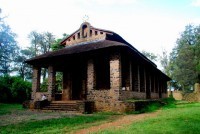


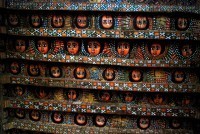
Blog post by Roderick Phillips, author of Weary Heart – a gut-wrenching tale of love and test tubes.
The post Debre Birhan Selassie Church, Day 304 appeared first on Roderick Phillips.
May 28, 2014
The Royal Enclosure, Gondar, Day 303
There are two draw cards for Gondar: one is as a base to organize trekking expeditions into the Simien mountains (which we have done previously and which are quite spectacular). The other and much easier to organize is a visit to the castles of the Royal Enclosure, located in the center of town. Before we take a lazy stroll through the African Camelot, though (and who knew there were castles in Africa. Well, OK, we did because we have been here before. But prior to that visit we had no idea) the idiosyncrasies of the Queen Taitu hotel (smelly bathroom, no hot water, alternating TV stations) proved to be, well, too idiosyncratic for us. So we move to a hotel aimed at backpackers that has just opened and recommended by Explore Abyssinia Travel yesterday. It seems to me that Ethiopia is changing fast. It is becoming more of a destination so if you want to see this pristine country go now before it’s too late. Enough proselytizing – alright just a bit more – Ethiopia is our favorite country in Africa (There, we’ve said - now on with the story). Our new hotel, the recently opened Lodge du Chateau, is run by Sayoum – who just happens to own Explore Abyssinia Travel (a sneaky piece of self-promotion that). In fact I think this hotel is so new that we are among its first guests! Anyway, he has the latest copy of the Lonely Planet Guide to Ethiopia, which he lends us. We pour over the latest information with relish as we eat an early lunch at the Golden Gate Asian restaurant. The restaurant even has a large photo of the Golden Gate Bridge as its center piece. Sad to say the food is terrible, but then why on earth are we eating Asian food in Ethiopia when Ethiopian food is so tasty and so unique.
Christi and I finally make it to the Royal Enclosure in the early afternoon and again we have the place virtually to ourselves (I love this). Six lofty and somewhat incongruous castles were built here between the mid 17th and mid 18th centuries to house successive emperors of Ethiopia. In addition to the castles there is a royal archive, a sauna, several lion cages, and stables. Undoubtedly the best preserved building is the castle of the Emperor Fasiladas who was the first to build a castle on this site. Constructed from rough-hewn brown basalt stone, the castle stands two storeys high, has a crenellated parapet, and four small, domed towers at the corners.
Some of the other buildings are now in ruins due in part to British bombing raids during WWII when the Italian army used the Royal Enclosure as its base. The African Camelot is, not surprisingly, a UNESCO world heritage site, although quite why the emperors decided to build European castles in the newly established capital of Gondar remains a mystery. Prior to the establishment of Gondar as its capital, the emperors of Ethiopia were nomadic rulers living in tents!
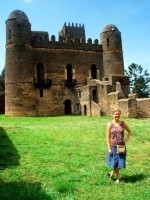
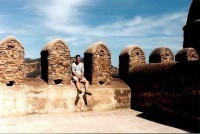
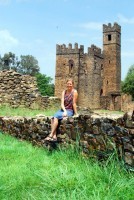
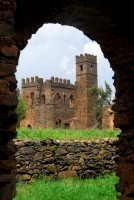
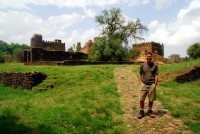
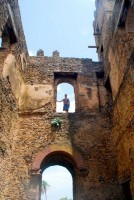
Blog post by Roderick Phillips, author of Weary Heart – a gut-wrenching tale of love and test tubes.
The post The Royal Enclosure, Gondar, Day 303 appeared first on Roderick Phillips.


